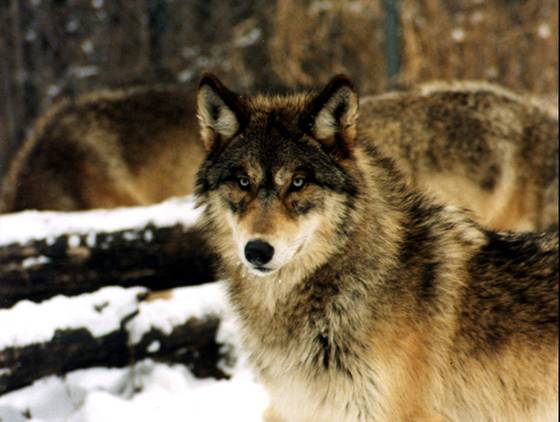Eastern wolves, once thought a gray wolf subspecies, qualify as a distinct wolf species, say federal researchers reviewing two decades of genetic analyses.

(Photo: Scott Flaherty)
November 17. 2012 - Along with towering oaks, glittering rivers and tribes of Native Americans, the Europeans who first colonized North America met wolves.
Wolves were an "apex" predator in colonial days, top of the ecological eat-or-be-eaten heap. They were also a little different from the wolves in Europe, noted naturalists, among them evolution's founder, Charles Darwin.
Writing in his 1859 book On the Origin of Species, which laid down the foundations of evolution as a science, Darwin reported, "There are two varieties of the wolf inhabiting the Catskill Mountains, in the United States, one with a light greyhound-like form, which pursues deer, and the other more bulky, with shorter legs, which more frequently attacks the shepherd's flocks."
Later that looked like one of Darwin's mistakes. In the decades afterward, while wolves were busily being exterminated almost entirely from the country by the descendants of those explorers, naturalists came to a different view: North America's wolves were just Europe's gray wolves all over, and the different types were just subspecies, instead of full-blown different species of wolves.
But thanks to genetics, Darwin's take on things is enjoying a revival, summed up in a recent survey of studies in the journal North American Fauna, a publication of the U.S. Fish and Wildlife Service. The implications may matter both for the future of wolves nationwide and for biologists looking at how species get their start, the subject Darwin first wrote about centuries ago.
While wolf experts agree that there is a gray wolf, or Canis lupus, and the red wolf, Canis rufus, now found in North Carolina, disagreements range over whether there are anywhere from eight to 27 subspecies of these wolves. "The lack of consensus among researchers on so many important issues related to the taxonomy (grouping) of North American wolves prompted the present review," begins the recent wolf report led by Fish and Wildlife Service biologist Steven Chambers.
Chambers and colleagues report the "most contentious" debate among researchers centers on the Eastern wolf, a slimmer, streamlined wolf that ranges in size from about 77 to 62 pounds, now found only in Canada. Is the Eastern wolf, Canis lupus lycaon (LY-can), a subspecies of the gray wolf, or is it simply Canis lycaon, a species of its own?
Weighing two decades of genetics studies, the review concludes that Eastern wolves are, indeed, a separate species. Most likely, the genetics indicate they sprang from a coyote-like ancestor several hundred thousand years ago, rather than directly from gray wolves.
"One thing that can be hard to understand is that different genetics researchers can disagree about what the genes mean," says DeLene Beeland, author of the upcoming book The Secret World of Red Wolves: The Fight to Save North America's Other Wolf. "With wolves, different researchers have looked at the same genes and disagreed about what they mean."
What makes assessing the status of Eastern wolves most difficult is that they mate with both gray wolves and with coyotes, Canis latrans. So, many of the wolves in the studies contain a mixture of genes from all three groups. Wolves in the Great Lakes, for example, look like a mixture of gray wolves and Eastern wolves, says the report.
"It is a debate, a real debate with real implications," says wolf researcher Paul Wilson of Canada's Trent University, who views Eastern wolves as a separate species. The fight isn't just about how many genes it takes to make a species distinct, but about what it means for separate new species of wolf to be declared. The issue comes amid a long-running political fight about "delisting" gray wolves as endangered in the American West and discussions of introducing wolves to Northeastern states.
Efforts to re-establish populations of red wolves in North Carolina and Mexican gray wolves in Arizona have led to contentious political fights. The authors of the review are careful to say their conclusions are not the official position of their agency, which delisted gray wolves in the Great Lakes as endangered in 2011.
People in Eastern states may have already gotten a taste of the reintroduction of Eastern wolves. Eastern wolves preferentially prey on white-tailed deer, unlike gray wolves, which are more wide-ranging in their tastes, and have one other notable difference with them: They mate with coyotes instead of preying on them. That may explain the appearance of hybrid "coy-wolves" preying on deer in Eastern states such as Connecticut in recent years. And it may explain how coyote genes are making their way into Western gray wolves. "Eastern wolves may act as a conduit for coyote genes making their way into gray wolves by mating with both of them," Wilson says.
From an evolutionary standpoint, it appears that gray wolves only invaded North America after Eastern wolves had split off from a coyote-like ancestor more than 150,000 years ago, White says. Ice Ages and an extinct species of North American wolves called Dire Wolves, as fearsome-looking as the name suggests, might have kept them out of the American West before then.
Darwin suggested that different landscapes and prey could lead to new species splitting off from one another over time in his 1859 book, pointing to wolves in the Catskills as an example. "As a scientist, I'd love to be in Darwin's company on the difference between these wolf species," White says.
source

No comments:
Post a Comment